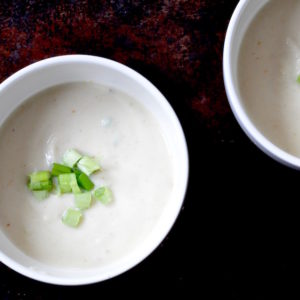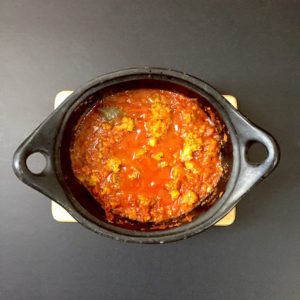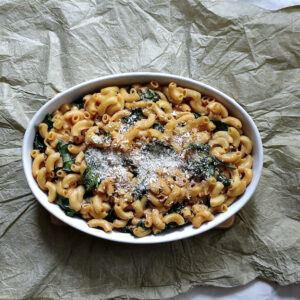Cauliflower Cheese
Cauliflower cheese is what the English call a faff. It is not difficult to prepare, but it takes a little time and dirties a few pots and pans. Just what you want to hear after the holidays, right?

Leftover from last post. I could say pseudo-meaningful things about life choices and the New Year and all that, but sometimes a picture of a train is just a picture of a train.
Returning to Cauiflower Cheese being a faff. Yes, there is modest fussing involved, but I promise it’s well worth the effort.

The dish is less about cauliflower, which sharp-eyed readers have already noticed is not cauliflower here, but broccolini.

Cauliflower cheese is really about the cheese sauce. This cheese sauce is transformative: anything it annoints becomes delicious. So delicious is this stuff, in fact, that you may yourself sampling it repeatedly as you cook. Don’t say you weren’t warned.

Lacking attractive cheese photos, I give you one of my kitchen cupboards.

More praise for cauliflower cheese: it is cheap. While you can use expensive cheeses, you probably shouldn’t. I am not suggesting the use of plastic products masquerading as “cheese food,” but neither should you use Bayley Hazen or Ticklemore. Further, this dish happily accepts whatever odd ends are hanging around in the cheese drawer. I know this because I went into making cauliflower cheese this time around with good intentions, always a joke in the face of collagen disease. My crummy health acted up just long enough for the cheeses to go off (yeah, I felt badly for a while), leaving me with a disparate collection of odd ends. And the dish was still scrumptious. Scrumptious isn’t a word much used around the IK, but it is applicable in this instance.

Returning briefly to the broccolini: you can make cauliflower cheese using cauliflower, of course, and it will be wonderful. You may also make it with other vegetables of your choosing. After preparing this a few weeks ago and posting it on instagram, I received a chorus of responses from English friends sharing their many recipes, from broccoli to beets to mixed vegetables.

A final plug: those of you trying to eat less animal protein will notice cauliflower cheese is vegetarian. Use the right cheese and it is vegan. Made carefully, cauliflower cheese is safe for celiacs. It is also kosher.

Above, toasted breadcrumbs and English mustard powder in a vintage Pyrex dish. Corner of cutting board, lower right, lends additional visual interest, drawing the eye downward. (Your hostess worked in the Art History Department of a major university. Her fluency in academic jargon is limited.)
My cauliflower cheese recipe is drawn from two books. The first is Ella Risbridger’s Midnight Chicken, which may be found online. Any cookbook that tackles mental illness, a boyfriend’s death, and manages to offer numerous lovely recipes simultaneously is well worth your time and money.

The second book is Tamasin Day-Lewis’s Tamasin’s Kitchen Bible, a book that lives up to its title.

A few preparation notes. Rather than parboil the cauliflower, I usually microwave or steam it, which saves water. If you live in an area where drought isn’t a concern, go ahead and parboil. The recipe will detail all these instructions.

A recipe involving cheese sauce naturally calls for grating cheese. The manual implements available for grating are hateful things, quick to grate anything they come into contact with. Worse, anyone grating large amounts of cheese knows that in short order you must stop to pick out the softened bits of cheese clogging the grater holes. Soon bits of cheesy fluff are everywhere. If you are a carpal tunnel sufferer, all of this is carried out in agony.

If any of you were wondering what in hell “cheese fluff” is, well, see above.
Yes, you can grate cheese with a food processor. But then you have to wash the processor. And the grating attachment.

All to say–this kvetching is going somewhere–I prefer to “grate” my cheese with a vegetable peeler. I find it is kinder to my hands and melts just as easily. (The cheese, that is, not the vegetable peeler.)

Cauliflower cheese is an excellent dish to prepare ahead and freeze. Prepare to the point of baking, then spoon the cauliflower cheese into a freezer-to-oven safe dish or several smaller dishes. You can then bake the dish from frozen one night when cooking feels impossible and ordering in feels even worse.

Cauliflower Cheese
Adapted from recipes in Ella Risbridger’s Midnight Chicken and
Tamasin Day-Lewis’s Kitchen Bible
Cauliflower cheese is not difficult to prepare, but it does require some time and concentration, to say nothing of pots and pans. Despite these drawbacks, this recipe is worth the effort.
Having all your ingredients prepped and pans ready really makes a difference here. It will also help to have two or three clean dishtowels for wiping your hands.
I also like to keep a spray bottle of white vinegar handy, along with some clean rags. This way I can clean up any messes or spills as they happen.
As always, please see the notes, below, for variations and more discussion.
about 8-10 ounces /250-400 grams cauliflower
4 tablespoons butter
4 tablespoons AP flour
3/4 cup/6 ounces/200ml milk or half-and-half
8 ounces/250 grams cheese: I used a mixture of parmesan and Cheddar
4 tablespoons panko
a little olive oil
salt and pepper (in same dish as the panko)
1 teaspoon English mustard (optional but nice, in same dish as panko, salt, and pepper)
Preheat the oven to 350F/180C
The cauliflower must be parboiled or steamed before baking. There are three ways to go about this.
The first is to place a medium saucepan of lightly salted water on to boil.
While you wait for the water to boil, either break the cauliflower apart or slice it into pieces. Once the water is boiling, lower the pieces of vegetable into the pot and cook, 4-5 minutes.
If you live in a drought stricken area, you have two options using less water. The first:
steam the cauliflower whole, using a vegetable steamer. This takes 15-20 minutes.
You may also microwave the cauliflower, either whole or broken apart. Total cooking time depends on your microwave. Mine took about ten minutes.
However you decide to cook your cauliflower, once it is cool enough to handle, break it apart if you haven’t already, and place it in a colander to cool completely while you make the cheese sauce.
As discussed in the post, cheese sauce requires grated cheese. Rather than grating two cheeses, I used a vegetable peeler to shave pieces of cheese into a deep bowl. This was much easier on my hands. Set the bowl of grated or shaved cheese aside.
Melt two tablespoons of butter over medium low heat. Use a medium saucepan. If you boiled the cauliflower, you can use the same saucepan. Once the butter is melted, add the flour and whisk like you mean it. As the roux comes together, the flour/butter mixture will lighten, thicken, and generally find itself. Depending on the size of your pan, there may be barely enough to cover the bottom.
Now gradually pour in your milk, whisking or stirring with a wooden spoon. The sauce may appear to seize or curdle. It’s okay. Just keep stirring. Add all the milk, stirring away. Crank up the heat a bit, until you get a little bit of bubbling around the edges of the pan.
Cheese time. Dump it all in and stir to blend. It will melt. This is good.
Okay, home stretch. We need to toast the breadcrumbs. Then we’re going to build our dish and bake it. The question is, what we are baking our cauliflower cheese in? A single baking dish? A cast iron pan? A few single serving dishes? The choice is yours.
Keep the cheese sauce warm while you decide how to proceed.
Once you’ve decided what sort of baking vessel to prepare your cauliflower cheese in, place a medium frying pan or cast iron pan on the stove. Pour the olive oil into it and heat over low. Gently toast your breadcrumb/mustard mixture. Yes, it’s a hassle. We’re almost done. Cook until you can smell the breadcrumbs, 2-4 minutes. Watch carefully to avoid burning. This isn’t the time to check your phone.
Scrape the breadcrumbs back into their bowl. Now add the cauliflower to the same pan, so it can pick up some incidental crunch. Cook for 3-4 minutes, just to give a bit of texture.
Okay, we are almost there.
In the vessel of your choosing, spread the cauliflower, followed by the cheese sauce. Shower with the crumbs. Bake 20-30 minutes. Cauliflower Cheese is ready when the dish is bubbling, browned, and smells ready.
You could serve cauliflower cheese with a salad, but why bother?
Once baked, cauliflower cheese will keep, wrapped and refrigerated, up to four days. It may be frozen, but the quality will suffer.
To freeze for another day, prepare cauliflower cheese up to baking in a freezer-proof pan or individual baking dishes. Wrap well in plastic wrap or tinfoil and freeze up to three months. Bake from frozen.
Notes:
As discussed in the post, use whatever winter vegetables suit your fancy. Members of the broccoli family are ideal here, as are potatoes, turnips, rutabagas, mushrooms, or a mixture of your favorites. Summer vegetables like tomatoes or cucumbers aren’t ideal in this dish, as they are too watery.
Ella Risbridger calls for salted butter in her recipe. I didn’t have salted, and didn’t notice a lack. Use what you like.
All the cauliflower cheese recipes I’ve encountered call for Gruyere and Parmesan. Lacking Gruyere, I used Parmesan and Cheddar to good effect.
Every cauliflower cheese recipe I’ve read called for some kind of spicing. Some call for small amounts of cayenne or chili powder. Others use mustard, either paste and powdered. I like Coleman’s mustard best. Use what you like. Sweet or hot paprikas are another option,
If you are cooking for celiac sufferers or vegans, adapt accordingly.
The breadcrumbs and seasonings are important to the dish: without them, stodge.
Thank you so much for reading.
Happy New Year!




